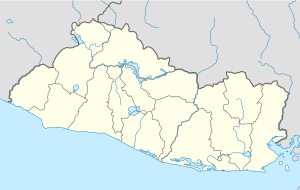Panchimalco
Planes de renderos | |
|---|---|
Municipality | |
| Coordinates: 13°37′N 89°11′W / 13.617°N 89.183°W | |
| Country | |
| Department | San Salvador Department |
| Area | |
| • Total | 30 sq mi (90 km2) |
| Elevation | 1,870 ft (570 m) |
| Population (2007) | |
| • Total | 41,260 |
Panchimal is a town in the San Salvador department of El Salvador.
Panchimalco ("The Place of Flags and Shields," from the
Indigenous people
Panchimalco is known for its indigenous population and its festivities. Together with
History
Panchimalco was founded by the pre-Columbian Toltec people who may have emigrated to the area following the fall of their empire in Tabasco in what is now Mexico.[6] During the Spanish conquest of the territory, the area was called "El Fuerte" (the fortress) because of the concave shape of the land that gave the indigenous population an advantage.[citation needed]
The Spanish established Panchimalco as a village, and built its famous colonial church, one of the most important historical monuments in El Salvador. Its original construction date, circa 1725, make it the oldest surviving colonial structure in El Salvador.
Culture
The festivities held in Panchimalco are colorful and religious in nature. The Flower & Fronds Fair (Feria de las Flores y Palmas) celebrates the

Nearby attractions include the town of Los Planes de Renderos, a lookout post where there are views of San Salvador and the valley; the "Puerta del Diablo" (Devil's Gate) rock formation and Balboa Park, a green retreat also overlooking San Salvador. All three are located within a municipal zone also called Panchimalco, though locals interpret Panchimalco to mean only the historic old town. The Panchimalco zone comprises 14 hamlets or cantons: El Divisadero, Pajales, Panchimalquito, Las Crucitas, San Isidro, Los Troncones, Azacualpa, Amayón, Los Palones, Los Planes de Renderos, el Guayabo, El Cedro, Quezalapa, Loma and Media.[1]
Panchimalco was named as among the ten top tourist sites in El Salvador by the Confederation of Latin American Tourist Organizations.[citation needed]
References
- ^ a b c "Diario Colatino - el Decano de la Prensa en El Salvador". Archived from the original on 2005-05-04. Retrieved 2006-09-19.
- ^ "El Salvador :: The people - Britannica Online Encyclopedia".
- ^ a b "Archived copy". Archived from the original on 2006-09-01. Retrieved 2006-09-19.
{{cite web}}: CS1 maint: archived copy as title (link) - ^ a b "En Panchimalco ya no se habla Náhuatl: 22 de marzo 2005 .::. El Diario de Hoy". Elsalvador.com.
- ^ "Cultural Survival". Culturalsurvival.org.
- ISBN 9781611923148. Retrieved 15 March 2019 – via Google Books.
- ^ "El Portal de El Salvador -ElSalvadorAqui.com- | Fotoreportajes -Panchimalco". Archived from the original on 2006-05-25. Retrieved 2006-09-19.
- ^ "Panchimalco un rinc?n desperdiciado - Hunnapuh - Comentarios". Hunnapauh.blogcindario.com.



